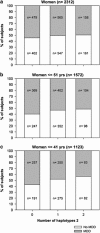A common and functional mineralocorticoid receptor haplotype enhances optimism and protects against depression in females
- PMID: 22832354
- PMCID: PMC3309494
- DOI: 10.1038/tp.2011.59
A common and functional mineralocorticoid receptor haplotype enhances optimism and protects against depression in females
Abstract
Mineralocorticoid (MR) and glucocorticoid receptors (GR) are abundantly expressed in the limbic brain and mediate cortisol effects on the stress-response and behavioral adaptation. Dysregulation of the stress response impairs adaptation and is a risk factor for depression, which is twice as abundant in women than in men. Because of the importance of MR for appraisal processes underlying the initial phase of the stress response we investigated whether specific MR haplotypes were associated with personality traits that predict the risk of depression. We discovered a common gene variant (haplotype 2, frequency ∼0.38) resulting in enhanced MR activity. Haplotype 2 was associated with heightened dispositional optimism in study 1 and with less hopelessness and rumination in study 2. Using data from a large genome-wide association study we then established that haplotype 2 was associated with a lower risk of depression. Interestingly, all effects were restricted to women. We propose that common functional MR haplotypes are important determinants of inter-individual variability in resilience to depression in women by differentially mediating cortisol effects on the stress system.
Figures




References
-
- de Kloet ER, Joels M, Holsboer F. Stress and the brain: from adaptation to disease. Nat Rev Neurosci. 2005;6:463–475. - PubMed
-
- Joels M, Karst H, DeRijk R, de Kloet ER. The coming out of the brain mineralocorticoid receptor. Trends Neurosci. 2008;31:1–7. - PubMed
-
- Holsboer F. The corticosteroid receptor hypothesis of depression. Neuropsychopharmacology. 2000;23:477–501. - PubMed
-
- DeBattista C, Belanoff J, Glass S, Khan A, Horne RL, Blasey C, et al. Mifepristone versus placebo in the treatment of psychosis in patients with psychotic major depression. Biol Psychiatry. 2006;60:1343–1349. - PubMed
-
- Holsboer F. The rationale for corticotropin-releasing hormone receptor (CRH-R) antagonists to treat depression and anxiety. J Psychiatr Res. 1999;33:181–214. - PubMed
Publication types
MeSH terms
Substances
Grants and funding
LinkOut - more resources
Full Text Sources
Other Literature Sources

